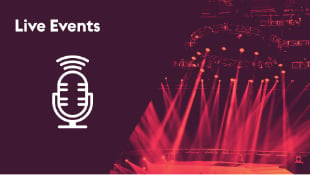NYC's Hammerstein Ballroom: An Event Waiting to Happen

Joan Jett is singing onstage with Alice Cooper, while the members of Cheap Trick are flailing away on their instruments nearby. A 25-foot screen behind them, fed by one of four in-house Ikegami HD cameras, makes the ensemble look larger than life, even in the rear balcony. Under the three-truss lighting grid, a doo-ragged figure approaches. Is that Steve Van Zandt? It is, and although the guitar says E Street Band, the swagger still has a bit of The Sopranos in it. At the clear Lucite lectern, a presenter doesn’t need the teleprompter, as she prepares to introduce Little Steven as the producer of the evening’s soireé.
On this night, Jett is the honoree of Little Kids Rock, a corporate charity that has rented out the Hammerstein Ballroom in New York City, complete with all the high-tech equipment and more. In 1906, theatrical impresario Oscar Hammerstein (grandfather to Oscar Hammerstein II, Richard Rodgers’ partner for musicals like South Pacific and The Sound Of Music) built the hall that now bears his name to compete with the established Metropolitan Opera by offering grand opera to New York’s teeming masses at lower ticket prices and with greater spectacle. He succeeded: Four years later, the Met cried “uncle,” offering Hammerstein $1.2 million to cease producing opera for the next decade.
The stage has hosted music artists all the way back to Judy Garland and Paul Robeson, and the venue’s tech credentials date back to 1926, when fledgling film company Warner Bros. set up a studio for the Vitaphone sound-on-disc system to record the 107-piece New York Philharmonic orchestra for the film Don Juan, the movie that marked the first commercial film featuring a recorded musical soundtrack. Recently, the Hammerstein Ballroom got a 21st-century facelift that has music acts and corporate event clients taking notice.
A Lot of Gear in a Short Time
One of a handful of high-end event-production spaces in Manhattan that compete for sophisticated international corporate and non-profit clients — along with venues like Cipriani and Terminal 5 — the 12,000-square-foot Hammerstein, which can hold 3,500 standing or 1,000 seated guests, views its audio, video and lighting (AVL) technology as part of its allure. For its clientele, a blend of historical context and leading-edge technology can be a potent combination. Its corporate portfolio includes events for AT&T, Condé Nast, Ford, Fortune Magazine and J.C. Penney.
“Oh, yes, we’re busy!” laughs Robert Carvell, director of technical services at the Hammerstein, which is part of the larger Manhattan Center. The Manhattan Center also houses a pair of recording studios, two television studios and a second event space, the Grand Ballroom, all linked via fiber and a Dante digital audio-networking system that can send synchronized audio and video among the spaces to support event production. “It’s very competitive at the high end of the market, and we all have our strengths and we play into those.”
In the Hammerstein, those strengths include an L-Acoustics K2 line array sound system, composed of a dozen K2 boxes and six SB28 subwoofers per side, hung from the venue’s soaring 75-foot ceiling. They’re powered by five LA8 networked amplifier racks (three amps per rack) and mixed through an Avid Profile console.
A three-truss lighting grid holds eight Martin Viper DX washes and eight 26-degree Lekos on the downstage limb; six Viper Profiles, eight Mac Auras and six Atomic strobes on the center truss, which complement another six Viper Profiles and eight Mac Aura; plus several strobes on the upstage arm. These are all controlled via an MA Lighting grandMA 2 console. Two Eiki 10K projectors, switched by a Panasonic 450 switcher, light up two 7-by-12-foot screens or a single 11-by-20-foot screen.
The installation of most of this gear was completed in August, the culmination of a two-year process that saw the venue radically alter its strategy. The corporate event-production market was heating up, shaking off the lengthy recession, and live music was establishing itself as the new engine for a challenged music industry. As those two worlds have become more entwined in recent years — what used to be considered “selling out to the man” is now often the brass ring for music artists, who pursue promotional deals as avidly as they once sought record deals — Hammerstein Ballroom has looked more and more like an event waiting to happen.
“We were seeing a definite uptick in corporate events taking place, especially ones involving significant music artists,” says Pete Auslan, Hammerstein’s production manager and himself a veteran of touring shows, having mixed front of house for Diana Ross, Ace Frehley, Jeffrey Osborne and others.
The venue had long been a site for both concerts and event production, but it relied on outside vendors for its AVL, with just a bare complement of in-house equipment. AV integrator See Factor kept small PA and lighting rigs on site, ratcheting up and down when needed. But, says Auslan, it wasn’t sufficient for complex productions.
Sizing up the competition, after joining the Hammerstein in 2011, Auslan realized that among the city’s largest event venues, Hammerstein and Roseland, another storied venue, were the only ones without installed systems. So he and Carvell created a plan to fit the space with an array of AVL products, chosen after detailed analyses of event and touring contract riders, as well as a poll of various FOH mixers and lighting designers.
“The most competitive event spaces had their own sound and lights,” Auslan says. “We could show that the cost and time needed to move rental systems in and out, and the labor for that, would justify investing in our own systems. Bringing the AV in house was a definite benefit to the client and for music.”
A budget was developed — part of a larger $3 million effort to also renovate the marquee and other elements of the center — and approved by the Unification Church, Manhattan Center’s owner. See Factor, with which the venue has an ongoing relationship, did the systems integration and installation.
The sound system was viewed as the core platform for the facility. Auslan made a spreadsheet of more than a dozen manufacturers, listing products, prices and a set of other criteria, such as reliability, rigging ease and “rider friendliness” — that last one being the most critical, he says. After auditioning most of the systems on the list, Auslan and company chose the L-Acoustics K2, which, in addition to its rider popularity, offered the best weight-to-power-to-cost ratio. But it wasn’t an easy decision.
“All these systems sound very good,” he says. “It’s impossible to disparage any of them. That’s how good the technology has become.”
Hammerstein’s chief lighting director, Billy Wong, led a similar research process for lights.
Finding ROI
Having made the decision to invest in its own AVL systems, Hammerstein Ballroom now faces the same challenge as its competitors: choosing systems that will remain technically relevant and professionally popular. Auslan says audio systems tend to stay viable longer than lighting. He cites the fact that many older systems, such as L-Acoustics’ V-DOSC and DV rigs, remain in use. Lighting technology, on the other hand, has experienced significant change in a short period of time, as LED technology has revolutionized the sector.
“We see a sound system lasting ten years, which is more than enough to get the return on investment,” he says. “Lighting tends to have a shorter lifespan, with new technologies superseding existing ones.”
The venue’s projectors are under consideration for replacement, while the video switcher, which had been used for the church’s Sunday worship service broadcasts for three years, will remain in place.
What, no in-house LED videowall? Carvell says that in the Hammerstein Ballroom’s case, there is insufficient demand for videowalls from corporate clients, and frankly, touring music artists tend to bring their own. “We do get requests for them from time to time, but not on the level that we were getting requests about sound or lights,” he says. “Videowalls can be rented as needed.”
What the last two years’ worth of AVL renovation has really done, though, is establish Hammerstein Ballroom’s identity in an increasingly crowded high-end event-production space. By making AVL a non-issue, through the acquisition of a rider-friendly collection, the venue can promote its inherent differentiators, such as its connectivity to adjacent audio and video recording facilities (VH1 recently set up shop there for 10 days for a live broadcast); its flexibility (it can easily blend music and other event activities simultaneously); and its sheer size. This year it hosted a conference of 200 mayors and their entourages, and satellite events for New York’s edition of the sprawling Comic Con convention.
“Actually, because of the ceiling height and rigging points, we really look at the space as New York’s smallest arena,” says Carvell, who acknowledges that jumping into the deep end of the AVL technology pool is complicated, but rewarding. “We’re so busy now that we’re afraid to see what’s coming next.”





.png?sfvrsn=519c2f3c_1)